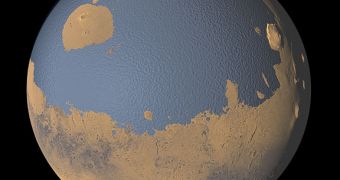We know now that Mars had flowing water on its surface once, and that it still has some water trapped on its surface in the form of ice. However, scientists have recently discovered that Mars might still have some water flowing of its surface. This comes as a result of a study made by professor Berry Lyons, from the Byrd Research Center at Ohio State University.
Several images of the Red Planets surface reveal similar structures to those created by flowing water on the surface that leaves a trail of sediments behind, which resemble the places where water flows, at the present, in McMurdo Dry Valleys in Antarctica. Due to the fact that there is no visible body of flowing water on Mars' surface, scientists suspect that water could be flowing under the surface of the planet, and could possibly hold bacterial life forms, just like those which live in the water flowing in Antarctica.
The Long Term Ecological Research Network, or LTER, led by Lyons consists in a collaboration of more than 1,800 scientists studying the ecology of different sites around the world. Dry Valleys, in Antarctica is one of these sites, having water running under its surface, and temperatures could be as low as the spots at Mars' equator. Also, the iron-rich soil at Dry Valleys looks eerie similar to that of the Martian landscape.
The LTER scientists made a comparative study of the Dry Valley and parts of the Martian surface, in order to see if they could spot possible evidence of recent flowing water of its surface. The results of their study will be presented tomorrow at the American Geophysicist Union in San Francisco.
Analysis of the water at Dry Valleys reveals that it is full of salts, which prevents it from freezing, thus surfacing in the water melted from the glaciers. According to Lyons, even in the middle of the winter in the Dry Valleys there can be found salty water covered by thin layers of ice, which as the temperature gets higher it evaporates, leaving behind its salty content.
Lyons argues that the same process could be available for Mars as well, but in this case, the salty water flows through under the surface of the Red Planet. He says that he will continue to lead other expeditions to Antarctica and compare the landscape of the Earth and of Mars, in order to learn more about our sister planet.

 14 DAY TRIAL //
14 DAY TRIAL //